Visualizing sound is kind of a trippy concept. There are some mesmerizing ways to do that, and also more mathematical ones, which I will explore both in this article.
Introduction
I wrote an [article] about lyrics-based song genre classifier before. I was wondering whether using the audio-based data will improve the performance. For this reason, this work takes a closer look at expoiting audio-based approach to build a multi-class classifier.
Audio Processing
Let’s take one song for instance,
Librosa
librosa is a python package for music and audio analysis. It provides the building blocks necessary to create music information retrieval systems. Let’s load the audio file we want to process first.
signal, sr = librosa.load("Halo.mp3")Great, a wonderful song, isn’t it? Then how does the sound look like in a graph?
Waveform
We can now take a look at its waveform. The waveform of a signal is the shape of its graph as a function of time, independent of its time and magnitude scales and of any displacement in time. Here is a interesting animation of waveform written by Josh Comeau.
plt.rcParams["figure.figsize"] = 15, 6
librosa.display.waveplot(signal, sr=sr, alpha=0.5)
plt.xlabel("Time")
plt.ylabel("Amplitude")
plt.show()
Sampling Rate
When we use librosa.load() we can set a parameter called “sr”, which stands for “sampling rate”, but what exactly does this mean? In audio production, a sampling rate defines how many times per second a sound is sampled, that is, the number of amplitude that can be recorded per second. For example, the sampling rate is 1khz, which means that the amplitude of 1000 waves can be recorded in one second.

The default sampling rate used by Librosa is 22050, but you can pass in almost any sampling rate you like. Further, the higher sample rate technically leads to more measurements per second and a closer recreation of the original audio, so 48 kHz is often used in “professional audio” contexts more than music contexts.
We can also indicate that sampling rate (Hz) is the inverse of the period
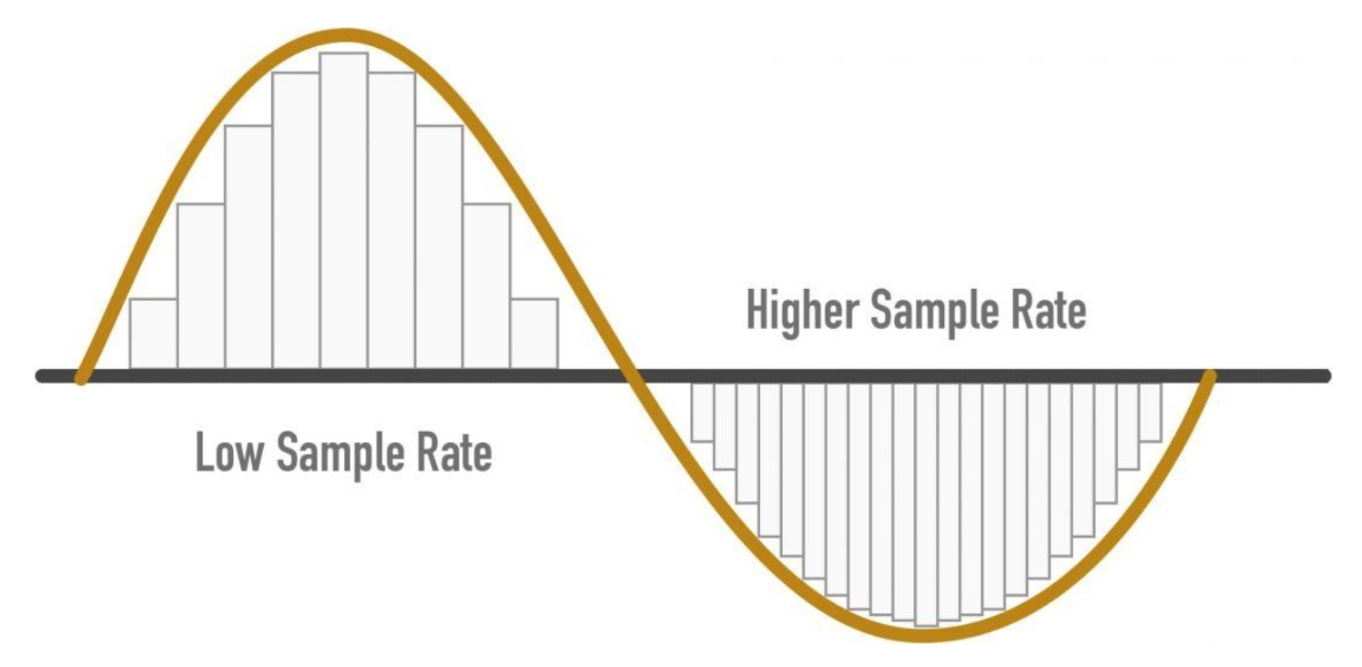
How many samples are necessary to ensure we are preserving the information contained in the signal? If the signal contains high frequency components, we will need to sample at a higher rate to avoid losing information that is in the signal. In general, to preserve the full information in the signal, it is necessary to sample at twice the maximum frequency of the signal. This is known as the Nyquist rate. The Sampling Theorem states that a signal can be exactly reproduced if it is sampled at a frequency F, where F is greater than twice the maximum frequency in the signal.
What happens if we sample the signal at a frequency that is lower that the Nyquist rate? When the signal is converted back into a continuous time signal, it will exhibit a phenomenon called ‘aliasing’. Aliasing is the presence of unwanted components in the reconstructed signal. These components were not present when the original signal was sampled. In addition, some of the frequencies in the original signal may be lost in the reconstructed signal. Aliasing occurs because signal frequencies can overlap if the sampling frequency is too low.
Frames
- Perceivable audio to chunk.
- Power of 2 # of samples.
- Typical values: 256 ~ 8192.
Formula for duration of a frame:
where
Spectral Leakage
- Processed signal isn’t an integer number of periods.
- Endpoints are discontinuous.
- Discontinuous appear as high-frequency components not present in the original signal.
Windowing
- Apply windowing function to each frame.
- Eliminates samples t both ends of a frame.
- Generates a periodic signal.
Hann Window
This function is a member of both the cosine-sum and power-of-sine families. The end points of the Hann window just touch zero.
At both endpoints will touch zero, which is a problem losing a signal. The solution to this is to overlap the frames.
Bit Depth & Bit Rate
Analog audio is a continuous wave, with an effectively infinite number of possible amplitude values. However, to measure this wave in digital audio, we need to define the wave’s amplitude as a finite value each time we sample it.
To illustrate bit depth, suppose you want to draw a picture of a sunset, but you only have 16 crayons. In real-life, sunsets come in a variety of colors, from dazzling yellows and oranges to faint reds and purples. If there were only 16 crayons, then it would be impossible to really draw all these different colors. What If you have 32 crayons, you can then use twice as many colors, although the picture still doesn’t look realistic. Thereupon, if you continue to add more crayons, you can definitely draw better.
The bit depth determines the number of possible amplitude values we can record for each sample. The most common bit depths are 16-bit, 24-bit, and 32-bit. Each is a binary term, representing a number of possible values. Systems of higher bit depths are able to express more possible values.
The bit rate of a file tells us how many bits of data are processed every second. Bit rates are usually measured in kilobits per second (kbps). To calculate the bit rate, we can use the following formula:
A typical, uncompressed high-quality audio file has a sample rate of 44,100 samples per second, a bit depth of 16 bits per sample and 2 channels of stereo audio. The bit rate for this file would be: 44100 samples per second × 16 bits per sample × 2 channels = 1411200 bits per second (or 1411.2 kbps).
To sum up, we can know that the higher the bit rate, the faster the data transfer speed. With a firmer understanding of sample rate and bit depth, let’s dive in next topic - spectrum.
Spectrum
Before we talk about the spectrum, we need to understand the sound waves first.

- Amplitude: the greater the amplitude, the louder the volume of the sound, and vice versa the lower the volume.
- Cycle: from position 0, to the peak, then to the trough, and finally back to 0, this is called a cycle.
- Frequency: frequency refers to how many cycles per second, the higher the frequency, the higher the pitch.
- Phase: indicates the position of the waveform in the cycle, measured in degrees.
- Wavelength: denotes the distance between two points with the same phase degree. The longer the wavelength, the lower the frequency, the shorter the wavelength, the higher the frequency.
So what is a Spectrum? A spectrum displays the different frequencies present in a sound.
fft = np.fft.fft(signal)
magnitude = np.absolute(fft)
frequency = np.linspace(0, sr, len(magnitude))
left_frequency = frequency[:int(len(frequency)/2)]
left_magnitude = magnitude[:int(len(magnitude)/2)]
plt.plot(left_frequency, left_magnitude, color="tab:blue")
plt.xlabel("Frequency")
plt.ylabel("Magnitude")
plt.grid()
plt.show()
I use np.fft.fft to perform Discrete Fourier Transform (DFT) with the efficient Fast Fourier Transform (FFT) algorithm. Fourier Transform is another mathematical representation of sound. Fourier Transform is a function that gets a signal in the time domain as input, and outputs its decomposition into frequencies.
The Fourier Transform is one of deepest insights ever made. Unfortunately, the meaning is buried within dense equations:
Rather than jumping into the symbols, let’s experience the key idea firsthand. Here’s a plain-English metaphor from this article:
- What does the Fourier Transform do? Given a smoothie, it finds the recipe.
- How? Run the smoothie through filters to extract each ingredient.
- Why? Recipes are easier to analyze, compare, and modify than the smoothie itself.
- How do we get the smoothie back? Blend the ingredients.
The Fourier Transform changes our perspective from consumer to producer, turning What do I have? into How was it made? In other words: given a smoothie, let’s find the recipe. In the process of filtration, the components and proportions do not change, so we can reverse the formula through this transformation, which is the meaning of the filter.
We can now derive the Discrete Fourier Transform from the continuous version of the Fourier series development.

Let’s implement discrete fourier transform in python.
def dft(x):
x = np.asarray(x, dtype=float)
N = x.shape[0]
cos = np.zeros_like(x)
sin = np.zeros_like(x)
X = []
for k in range(N):
real, image = 0, 0
for n in range(N):
real += x[n] * math.cos(2 * math.pi * k * n / N)
image += x[n] * math.sin(2 * math.pi * k * n / N)
X.append(complex(real, image))
return np.array(X)Check whether it is correct.
x = np.random.rand(1000, )
((fft(x) - np.fft.fft(x)) < 1e-10).all()TrueIntuition
- Decompose a complex sound into its frequency components.
- Convert time domain to frequency domain.
- Compare signal with sinusoids of various frequencies.
- For each frequency we get a magnitude and a phase.
- High magnitude indicates high similarity bwtween the signal and a sinunoid.
Reconstruct the signal
- Superimpose sinusoids
- Weight them bu the relative magnitude
- Use relative phase
- Original signal and FT have same information
Inverse Fourier Transform
- Additive synthesis (waveform -> spectrum -> waveform)
Spectrogram
Short-time Fourier transform (STFT) is a sequence of Fourier transforms of a windowed signal. STFT provides the time-localized frequency information for situations in which frequency components of a signal vary over time, whereas the standard Fourier transform provides the frequency information averaged over the entire signal time interval. In this work, I use STFT to obtain sprectrogram.
A spectrogram is a visual way of representing the signal strength, or “loudness”, of a signal over time at various frequencies present in a particular waveform. Not only can one see whether there is more or less energy at, but one can also see how energy levels vary over time.
n_fft = 2048
hop_length = 512
stft = librosa.core.stft(signal, n_fft=n_fft, hop_length=hop_length)
spectrogram = np.abs(stft)
log_spectrogram = librosa.amplitude_to_db(spectrogram)
librosa.display.specshow(log_spectrogram, sr=sr, hop_length=hop_length)
plt.xlabel("Time")
plt.ylabel("Frequency")
plt.colorbar()
plt.show()
Mel-frequency Cepstrum Coefficients (MFCC)
Mel-frequency cepstral coefficients (MFCCs) are coefficients that collectively make up an MFC. They are derived from a type of cepstral representation of the audio clip (a nonlinear “spectrum-of-a-spectrum”). The advantage of MFCC is that it is good in error reduction and able to produce a robust feature when the signal is affected by noise.
mfcc = librosa.feature.mfcc(signal, n_fft=n_fft, hop_length=hop_length, n_mfcc=13)
librosa.display.specshow(mfcc, sr=sr, hop_length=hop_length)
plt.xlabel("Time")
plt.ylabel("MFCC")
plt.colorbar()
plt.show()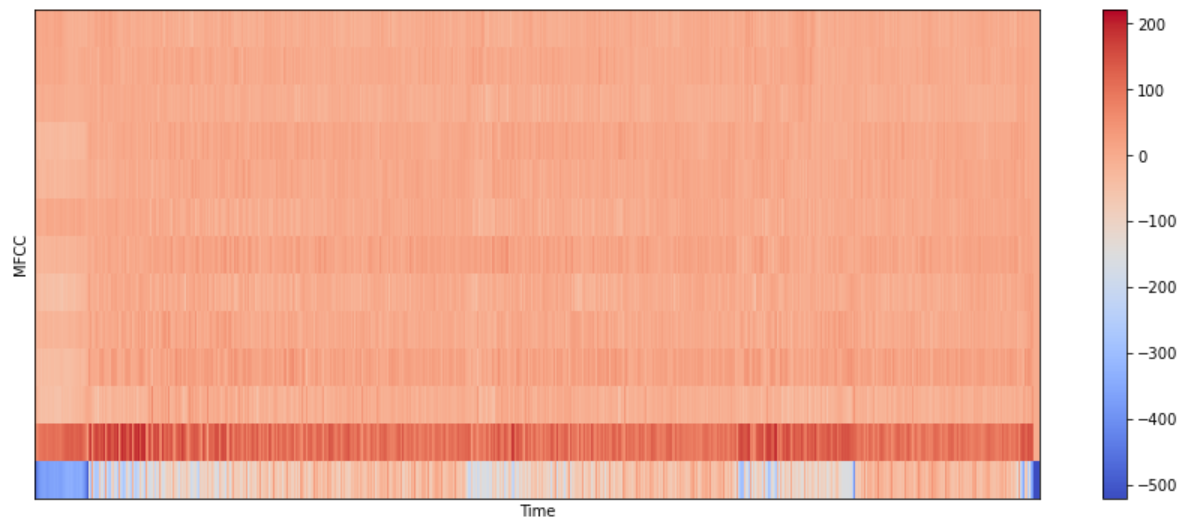
Time-domain Features
- Amplitude envelope (AE)
- Root-mean-square energy (RMS)
- Zero-crossing rate (ZCR)
Amplitude envelope
- Max value of all samples in a frame:
- Gives rough idea of loudness
- Sensitive to outliers
- Onset detection, music genre classification
def amplitude_envelope(signal, frame_length, hop_length):
amplitude_envelope = []
for i in range(0, len(signal), hop_length):
current_frame_amplitude_envelope = max(signal[i:i+frame_length])
amplitude_envelope.append(current_frame_amplitude_envelope)
return np.array(amplitude_envelope)
FRAME_LENGTH = 1024
HOP_LENGTH = 512
ae_blank_space = amplitude_envelope(blank_space, FRAME_LENGTH, HOP_LENGTH)
frames = range(0, ae_blank_space.size)
t_interval = librosa.frames_to_time(frames, hop_length=HOP_LENGTH)
librosa.display.waveplot(blank_space, alpha=0.5)
plt.plot(t_interval, ae_blank_space, color="tab:red")
plt.title("Taylor Swift Blank Space Amplitude Envelope")
plt.ylim((-1, 1))
plt.show()
Root-mean-square energy
- RMS of all samples in a frame:
- Indicator of loudness.
- Less sensitive to outliers than AE.
- Audio segmentation, music genre classification
FRAME_LENGTH = 1024
HOP_LENGTH = 512
rms_blank_space = librosa.feature.rms(blank_space, frame_length=FRAME_LENGTH, hop_length=HOP_LENGTH)[0]
frames = range(0, rms_blank_space.size)
t_interval = librosa.frames_to_time(frames, hop_length=HOP_LENGTH)
librosa.display.waveplot(blank_space, alpha=0.5)
plt.plot(t_interval, rms_blank_space, color="tab:red")
plt.title("Taylor Swift Blank Space Root-mean-square energy")
plt.ylim((-1, 1))
plt.show()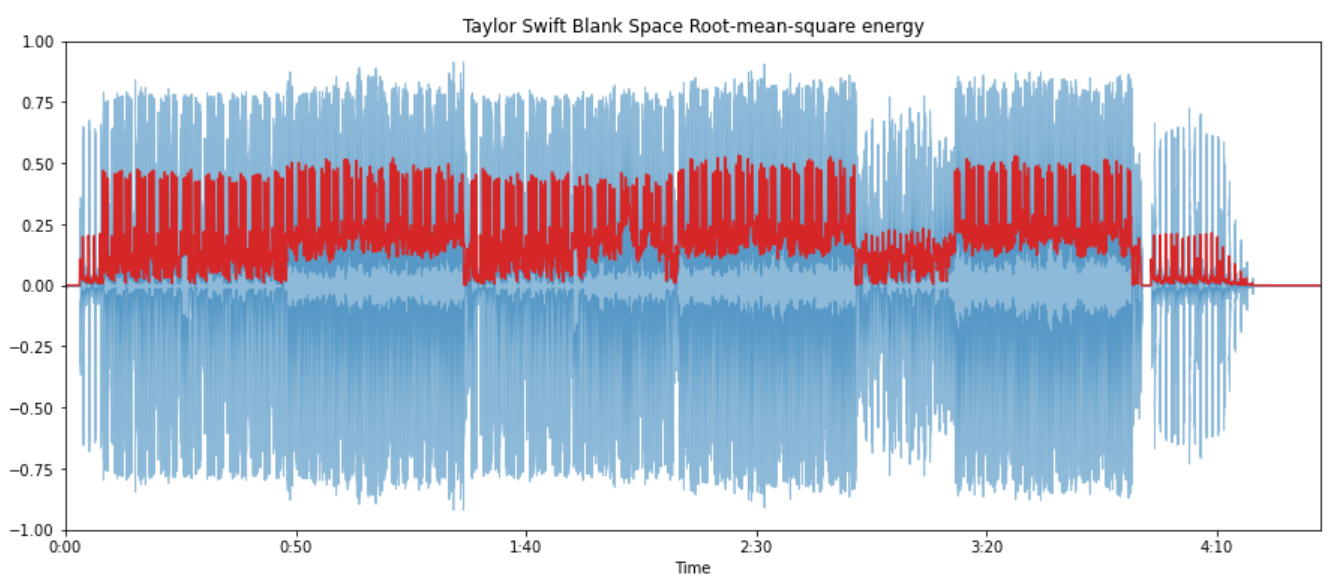
We can also build the function by ourselves.
def root_mean_square(signal, frame_length, hop_length):
rms = []
for i in range(0, len(signal), hop_length):
current_frame_rms = np.sqrt(np.sum(np.square(signal[i:i+frame_length])) / frame_length)
rms.append(current_frame_rms)
return np.array(rms)
rms_blank_space_from_scratch = root_mean_square(blank_space, FRAME_LENGTH, HOP_LENGTH)
frames = range(0, rms_blank_space_from_scratch.size)
t_interval = librosa.frames_to_time(frames, hop_length=HOP_LENGTH)
librosa.display.waveplot(blank_space, alpha=0.5)
plt.plot(t_interval, rms_blank_space_from_scratch, color="tab:red")
plt.title("Taylor Swift Blank Space Root-mean-square energy from scratch")
plt.ylim((-1, 1))
plt.show()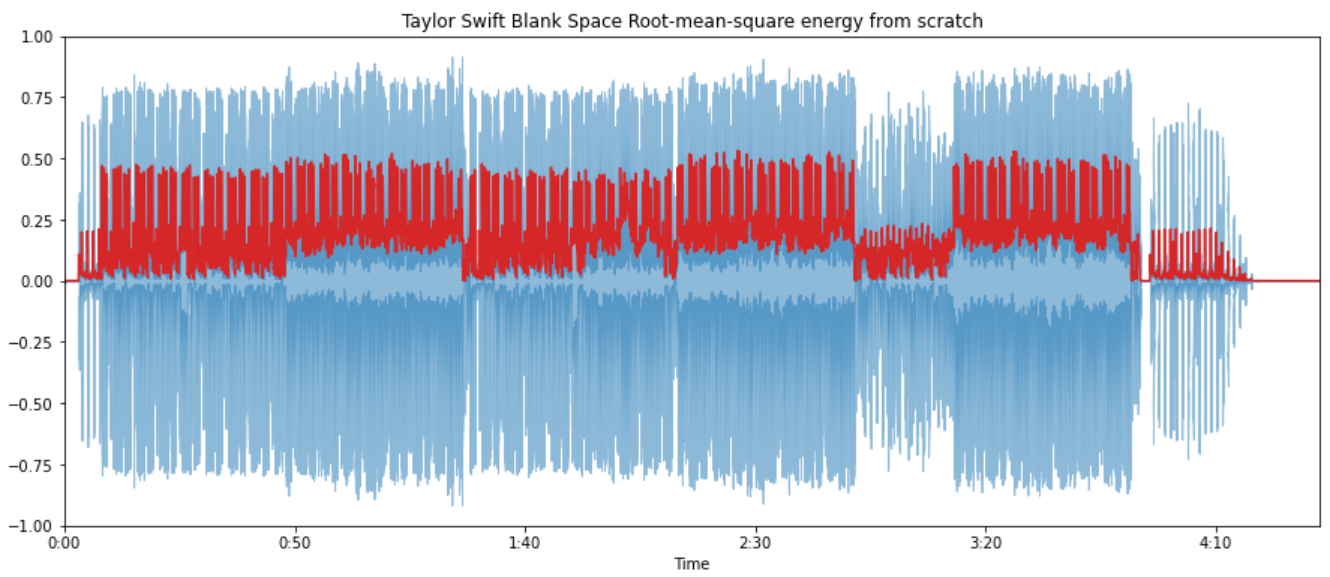
Zero-crossing rate
- Number of times a signal crosses the horizontal axis:
- Recognition of percussive vs pitched sounds
- Monophonic pitch estimation
- Voice / Unvoiced decision for speech signals
zrc_blank_space = librosa.feature.zero_crossing_rate(blank_space, frame_length=FRAME_LENGTH, hop_length=HOP_LENGTH)[0]
frames = range(0, zrc_blank_space.size)
t_interval = librosa.frames_to_time(frames, hop_length=HOP_LENGTH)
plt.plot(t_interval, zrc_blank_space*FRAME_LENGTH, color="tab:red")
plt.title("Taylor Swift Blank Zero-crossing rate")
plt.ylim((-50, 600))
plt.show()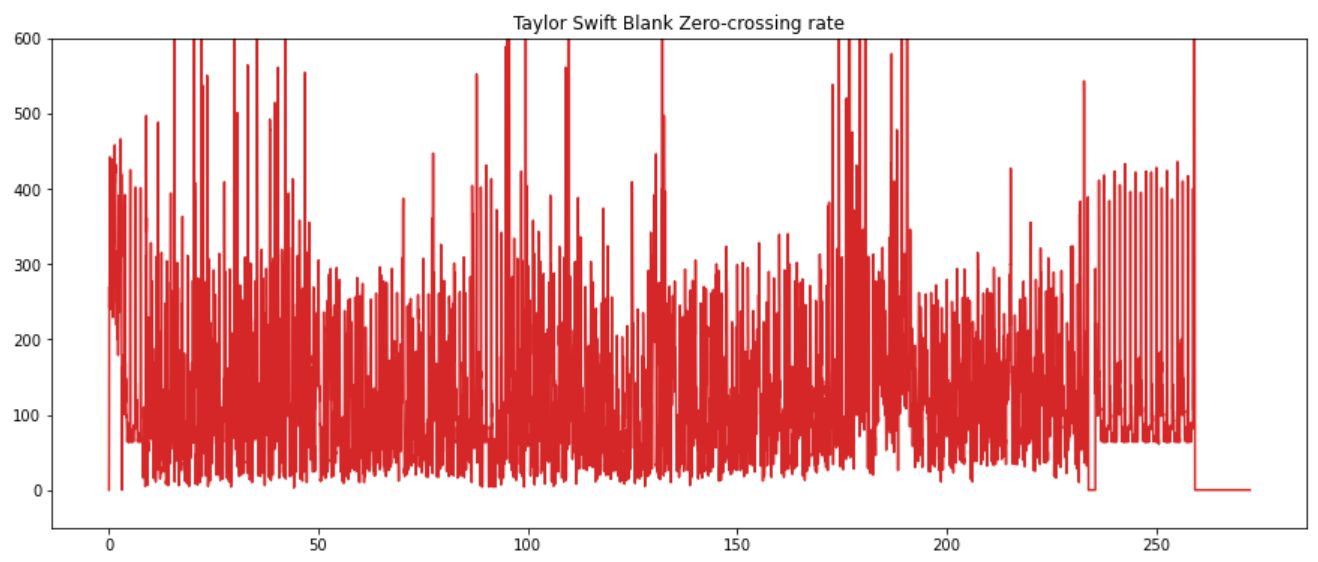
Prepare Data
import os
import json
import math
DATASETPATH = "mp3"
JSONPATH = "data.json"
def save_mfcc(dataset_path, json_path, sr=22050, duration=30, n_mfcc=13, n_fft=2048, hop_length=512, num_segment=5):
data = {
"mapping": [],
"mfcc": [],
"labels": []
}
samples_per_track = sr * duration
num_samples_per_segment = int(samples_per_track / num_segment)
expected_num_mfcc_vectors_per_segment = math.ceil(num_samples_per_segment / hop_length)
# Loop through all the genre folders
for i, (dirpath, dirnames, filenames) in enumerate(os.walk(dataset_path)):
if dirpath is not dataset_path:
# Save semantic labels
dirpath_components = dirpath.split("/")
semantic_label = dirpath_components[-1]
data["mapping"].append(semantic_label)
print(f"\nProcessing {semantic_label}")
# Process files for a specific genres
for f in filenames:
file_path = os.path.join(dirpath, f)
signal, sr = librosa.load(file_path, sr=sr)
# Process segments extracting mfcc and store data
for s in range(num_segment):
start_sample = num_samples_per_segment * s
finish_sample = start_sample + num_samples_per_segment
mfcc = librosa.feature.mfcc(signal[start_sample:finish_sample],
sr=sr,
n_mfcc=13,
n_fft=2048,
hop_length=512)
mfcc = mfcc.T
# Store mfcc for segment if it has the expected length
if len(mfcc) == expected_num_mfcc_vectors_per_segment:
data["mfcc"].append(mfcc.tolist())
data["labels"].append(i-1)
print(f"{file_path} | segments: {s+1}")
# Save data to a json file
with open(json_path, "w") as fp:
json.dump(data, fp, indent=4)
def load_data(json_path):
with open(json_path, "r") as fp:
data = json.load(fp)
features = np.array(data["mfcc"])
targets = np.array(data["labels"])
return features, targets
save_mfcc(DATASETPATH, JSONPATH)
features, targets = load_data(JSONPATH)Split the data into training dataset and validation dataset.
from sklearn.model_selection import train_test_split
X_trainvalid, X_test, y_trainvalid, y_test = train_test_split(features, targets, test_size=0.1, stratify=targets)
X_train, X_valid, y_train, y_valid = train_test_split(X_trainvalid, y_trainvalid, test_size=0.125, stratify=y_trainvalid)Modeling
Load the libraries.
import tez
import torch
import torch.nn as nn
from sklearn import metrics, model_selection, preprocessing
from tez.callbacks import EarlyStopping
from tez import enums
from tez.utils import AverageMeter
from torch.utils.data import Dataset
from torch.nn import functional as F
from collections import defaultdict
from tqdm import tqdmCreate Dataset() class from PyTorch.
class SongGenreDataset(Dataset):
def __init__(self, features, targets):
self.features = features
self.targets = targets
def __len__(self):
return len(self.features)
def __getitem__(self, idx):
target = self.targets[idx]
target = np.array(target)
target = target.astype(np.float64)
feature = self.features[idx]
feature = np.array([feature])
feature = feature.astype(np.float64)
feature = np.expand_dims(feature, axis=1)
sample = {
'feature': torch.from_numpy(feature).float(),
'target': torch.from_numpy(target)}
return sampletrain_dataset = SongGenreDataset(X_train, y_train)
valid_dataset = SongGenreDataset(X_valid, y_valid)
test_dataset = SongGenreDataset(X_test, y_test)Create a simple MLP model.
class SongGenreMLPClassifier(tez.Model):
def __init__(self, num_classes):
super().__init__()
self.dropout = nn.Dropout(0.1)
self.fc1 = nn.Linear(259*13, 128)
self.out = nn.Linear(128, num_classes)
self.step_scheduler_after = "epoch"
self.num_classes = num_classes
self.history = defaultdict(list)
def monitor_metrics(self, outputs, targets):
if targets is None:
return {}
outputs = torch.argmax(outputs, dim=1).cpu().detach().numpy()
targets = targets.cpu().detach().numpy()
accuracy = metrics.accuracy_score(targets, outputs)
return {"accuracy": accuracy}
def fetch_optimizer(self):
opt = torch.optim.Adam(self.parameters(), lr=3e-4)
return opt
def fetch_scheduler(self):
sch = torch.optim.lr_scheduler.CosineAnnealingWarmRestarts(
self.optimizer, T_0=10, T_mult=1, eta_min=1e-6, last_epoch=-1
)
return sch
def train_one_epoch(self, data_loader):
self.train()
self.model_state = enums.ModelState.TRAIN
losses = AverageMeter()
tk0 = tqdm(data_loader, total=len(data_loader))
for b_idx, data in enumerate(tk0):
self.train_state = enums.TrainingState.TRAIN_STEP_START
loss, metrics = self.train_one_step(data)
self.train_state = enums.TrainingState.TRAIN_STEP_END
losses.update(loss.item(), data_loader.batch_size)
if b_idx == 0:
metrics_meter = {k: AverageMeter() for k in metrics}
monitor = {}
for m_m in metrics_meter:
metrics_meter[m_m].update(metrics[m_m], data_loader.batch_size)
monitor[m_m] = metrics_meter[m_m].avg
self.current_train_step += 1
tk0.set_postfix(loss=losses.avg, stage="train", **monitor)
tk0.close()
self.update_metrics(losses=losses, monitor=monitor)
for k, v in monitor.items():
self.history[f"train_{k}"].append(v)
self.history["train_loss"].append(losses.avg)
return losses.avg
def validate_one_epoch(self, data_loader):
self.eval()
self.model_state = enums.ModelState.VALID
losses = AverageMeter()
tk0 = tqdm(data_loader, total=len(data_loader))
for b_idx, data in enumerate(tk0):
self.train_state = enums.TrainingState.VALID_STEP_START
with torch.no_grad():
loss, metrics = self.validate_one_step(data)
self.train_state = enums.TrainingState.VALID_STEP_END
losses.update(loss.item(), data_loader.batch_size)
if b_idx == 0:
metrics_meter = {k: AverageMeter() for k in metrics}
monitor = {}
for m_m in metrics_meter:
metrics_meter[m_m].update(metrics[m_m], data_loader.batch_size)
monitor[m_m] = metrics_meter[m_m].avg
tk0.set_postfix(loss=losses.avg, stage="valid", **monitor)
self.current_valid_step += 1
tk0.close()
self.update_metrics(losses=losses, monitor=monitor)
for k, v in monitor.items():
self.history[f"valid_{k}"].append(v)
self.history["valid_loss"].append(losses.avg)
return losses.avg
def forward(self, feature, target=None):
target = target.long().to(self.device)
x = feature.reshape(feature.shape[0], -1)
x = F.relu(self.fc1(x))
outputs = self.out(self.dropout(x))
outputs = outputs.float().to(self.device)
if target is not None:
loss = nn.CrossEntropyLoss()(outputs, target)
metrics = self.monitor_metrics(outputs, target)
return outputs, loss, metrics
return outputs, None, None
def score(self, test_dataset, n_jobs=0):
def softmax(x):
return np.exp(x) / np.sum(np.exp(x), axis=0)
prediction = self.predict(test_dataset, n_jobs=n_jobs)
prediction = list(prediction)
prediction = softmax(np.vstack(prediction))
prediction = np.argmax(prediction, axis=1)
groud_truth = test_dataset[:]["target"].detach().numpy().astype(np.int64)
return metrics.accuracy_score(prediction, groud_truth)
def plot_history(self):
from matplotlib.ticker import MaxNLocator
train_loss, valid_loss = self.history["train_loss"], self.history["valid_loss"]
train_accuracy, valid_accuracy = self.history["train_accuracy"], self.history["valid_accuracy"]
plt.rcParams["figure.figsize"] = 15, 6
ax1 = plt.subplot(2, 1, 1)
ax1.plot(range(1, len(train_loss)+1), train_loss, color="tab:blue", label="train")
ax1.plot(range(1, len(valid_loss)+1), valid_loss, color="tab:orange", label="valid")
ax1.xaxis.set_major_locator(MaxNLocator(integer=True))
ax1.title.set_text('Loss')
ax1.grid()
ax2 = plt.subplot(2, 1, 2)
ax2.plot(range(1, len(train_accuracy)+1), train_accuracy, color="tab:blue", label="train")
ax2.plot(range(1, len(valid_accuracy)+1), valid_accuracy, color="tab:orange", label="valid")
ax2.xaxis.set_major_locator(MaxNLocator(integer=True))
ax2.title.set_text('Accuracy')
ax2.grid()
plt.tight_layout()
plt.show()Start training!
model = SongGenreMLPClassifier(num_classes=3)
MODEL_PATH = "./models/"
MODEL_NAME = "SongGenreMLPClassifier"
es = EarlyStopping(
monitor="valid_loss",
model_path=os.path.join(MODEL_PATH, MODEL_NAME + ".bin"),
patience=15,
mode="min",
)
model.fit(
train_dataset,
valid_dataset=valid_dataset,
train_bs=16,
valid_bs=16,
device="cuda",
epochs=10,
fp16=True,
callbacks=[es],
n_jobs=0
)
model.plot_history()
Conclusion
In the end, we got a accuracy score of 50.7% on the test dataset. For your information, I only utilise 150 songs, which is not a large amount of data, but it achieves a higher score than most of the lyrics-based models (this article I wrote before). In the future, I will investigate more different models to improve the performance for the audio-based classifier! Stay tuned!
References
- https://github.community/t/is-it-possible-to-open-a-sound-file/10377/2
- https://developer.mozilla.org/en-US/docs/Web/HTML/Element/audio
- https://www.izotope.com/en/learn/digital-audio-basics-sample-rate-and-bit-depth.html
- https://www.youtube.com/watch?v=daB9naGBVv4&list=RDCMUCZPFjMe1uRSirmSpznqvJfQ&index=6&ab_channel=ValerioVelardo-TheSoundofAI
- http://www2.egr.uh.edu/~glover/applets/Sampling/Sampling.html
- https://www.dewresearch.com/products/163-derivation-of-the-dft
- https://teropa.info/harmonics-explorer/
- https://towardsdatascience.com/extract-features-of-music-75a3f9bc265d
- https://haythamfayek.com/2016/04/21/speech-processing-for-machine-learning.html
- https://www.kaggle.com/ilyamich/mfcc-implementation-and-tutorial

